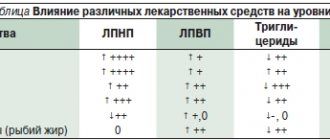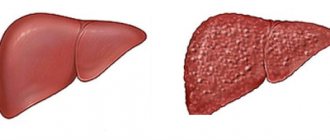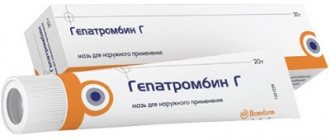Peripheral circulation disorders
The main peripheral circulatory disorders are:
- hyperemia (arterial and venous) – increased blood supply to the tissue;
- ischemia – a decrease in blood supply to an organ or tissue;
- stasis – cessation of blood flow in organs and tissues.
Arterial hyperemia is an increase in the blood supply to an organ due to an increase in the amount of blood flowing through its dilated vessels.
There are physiological hyperemia, which occurs normally with increased organ function, as well as reflexively under the influence of ultraviolet rays, cold, heat, etc., as well as pathological hyperemia, which occurs in the following cases:
- with inflammation;
- with rapid decompression of compressed vessels (for example, when emptying the abdominal cavity from the accumulation of ascitic fluid);
- when creating a rarefied space (vacuum hyperemia) - for example, when using medical cups;
- with overload or drug blockade of the sympathetic nerves that constrict blood vessels (neuroparalytic hyperemia).
Clinically, arterial hyperemia is manifested by redness of tissues and a local increase in their temperature.
Venous (congestive) hyperemia is an increase in blood supply to a tissue area with a decrease in the amount of flowing blood.
Causes of venous hyperemia:
- thrombosis or compression of veins from the outside (tumor, scars, pregnant uterus, surgical ligation of a vessel);
- stagnation and slowing of blood flow in the veins of the lower body with a decrease in the pumping function of the heart (right ventricular heart failure);
- blood stagnation in the lower extremities in people who work for a long time while standing.
Clinically, venous hyperemia is manifested by a bluish color of tissue or cyanosis, and may also be accompanied by edema.
Stasis is a local stop of blood flow in small vessels, mainly capillaries. Stasis occurs due to a complete cessation of blood flow, due to a sharp disruption of blood outflow, as well as due to various diseases of an inflammatory and non-inflammatory nature (true capillary stasis), leading to intracapillary crowding (aggregation) of red blood cells and stopping capillary blood flow.
Stasis can be reversible or irreversible (in this case, blood flow is not restored, and necrosis occurs in the corresponding area of tissue). Externally, when stasis occurs, a “marbled” color may appear on the skin.
Sludge (sludge syndrome) is a blood condition based on the aggregation of red blood cells. The development of sludge represents an extreme degree of expression of the aggregation of blood cells. The main features of blood sludge are: adhesion of formed elements to each other and an increase in plasma viscosity, which leads to a state of blood that makes it difficult for blood to flow through small-caliber vessels.
Ischemia is the reduced blood supply to any area of tissue due to weakening or cessation of blood flow to it through the arteries.
Causes of ischemia:
- compression of the artery (with a tourniquet, tumor, scar, foreign body, surgical ligation of the vessel);
- blockage of an artery (thrombus, embolus, narrowing of the lumen of the artery due to vascular diseases);
- reflex ischemia (when exposed to painful, visual, sound, chemical, emotional stimuli, etc.).
Clinical manifestations of ischemia depend on the location of the ischemic area. With ischemia of the limbs, their pallor, a feeling of numbness, “pins and needles”, pain occur, and the function of the limb is impaired. With ischemia of the heart muscle, pain occurs in the heart, and with ischemia of the brain, one or another neurological symptoms occur.
The outcomes of ischemia depend not only on the location, but also on the diameter of the switched off vessel and on the degree of development of collateral (roundabout) circulation in this area. With a favorable outcome, the blood supply to the ischemic area is restored; with an unfavorable outcome, an area of tissue necrosis occurs - an infarction.
The usefulness of collateral (roundabout) blood circulation depends on the anatomical features of the blood supply to the ischemic area (mainline or branched type of blood supply), the state of the vascular wall, the state of cardiac activity and the nervous regulators of blood circulation. There are functionally absolutely sufficient and functionally insufficient (absolutely and relatively) collaterals. This accordingly affects the nature of the outcome of ischemia.
Thrombosis is the intravital coagulation of blood or lymph in the lumen of a vessel with partial or complete blockage, leading to disruption of blood flow.
The mechanism of thrombus formation consists of a combination of three factors (Virchow’s triad): – slowing down of blood flow; – damage to the vascular wall; – increased blood clotting.
Vein thrombosis is also called phlebothrombosis. If thrombosis is combined with inflammation of the vein wall, then they speak of thrombophlebitis. If there is a combination of thrombosis of an artery with inflammation of its wall, this is called thromboarteritis.
Embolism is the blockage of blood and lymphatic vessels by particles carried by the blood or lymph flow. These particles are called emboli.
The following types of embolism are distinguished:
- thromboembolism - embolism by a migrated fragment of a thrombus;
- tissue and cellular embolism - embolism of a tissue area due to organ injury, tumor cells, etc.;
- fat embolism - blockage of blood vessels with drops of fat, most often due to fractures of long tubular bones;
- gas embolism (an option is air embolism) - blockage of blood vessels by gas bubbles, for example, bubbles of nitrogen dissolved in the blood during decompression sickness in divers;
- bacterial embolism – blockage of blood vessels by bacterial conglomerates in various diseases (acute hematogenous osteomyelitis);
- embolism by a foreign body (bullet, shell fragment).
If the embolus, due to gravity, falls from top to bottom against the direction of blood flow, then they speak of a retrograde embolism. If an embolus from the venous system enters the arterial system through an unprotected septum between the left and right atria, then this embolism is called paradoxical.
Thrombosis and embolism of arterial vessels leads to ischemia of the blood supply areas of these vessels. Venous thrombosis leads to the occurrence of venous stagnation in the areas of venous outflow of a given vessel.
The fate of the blood clot can be different. Over time, the thrombus can grow with connective tissue (organization of a blood clot), partially or completely dissolve (recanalization of a blood clot), or undergo purulent melting.
Bleeding is the outpouring of blood from the lumen of a vessel into surrounding tissues, natural cavities of the body, or into the external environment.
There are arterial, venous, capillary and mixed bleeding. bleeding most often occurs when the vascular wall is damaged, but it can also occur through an intact vessel wall (diapedetic bleeding). Damage to the vessel wall occurs as a result of injury, but can also be the result of a pathological process - corrosion of the vessel wall due to purulent inflammation or a tumor process (arrosive bleeding). An accumulation of blood in soft tissue is called a hematoma. When blood flows into soft tissues and natural cavities of the body, we speak of internal bleeding, and blood flow into the external environment (including into the lumen of the digestive tract) is called external bleeding.
With intense (profuse) bleeding, activation of the blood coagulation system occurs, which leads to multiple thrombus formation in small vessels. This leads to a deficiency of fibrinogen in the blood plasma, a decrease in the blood's ability to clot and increased bleeding. This condition is called disseminated intravascular coagulation (DIC).
Circulatory disorders of the lower extremities
General information
The human blood circulation is a closed vascular pathway that provides a continuous flow of blood, carrying oxygen and nutrition to cells, carrying away carbon dioxide and metabolic products. Blood, saturated with nutrients and oxygen, moves through the arteries from the heart to the organs and tissues. If blood flow in the arteries supplying the lower extremities is impaired due to the progression of atherosclerosis, then their tissues receive insufficient oxygen and nutrients and a disease called “peripheral artery disease” or “leg artery disease” develops.
Symptoms of circulatory disorders:
- feeling of discomfort/pain when walking;
- pain in the areas of the lower extremities (foot, shin, knee).
The risk of developing the disease increases with age. In the age group over 70 years, one in three people suffers peripheral artery In addition, smoking and diabetes increase the risk of developing this disease.
In rare cases, disease of the peripheral arteries of the lower extremities is asymptomatic. A common symptom of the disease is intermittent claudication. It is expressed in discomfort in the lower extremities, which occurs when walking and disappears when it stops. The patient may experience pain and the following symptoms:
- convulsions;
- weakness in the lower extremities;
- intermittent lameness (when going up).
As the disease progresses, intermittent claudication begins to occur over increasingly shorter distances. Ischemia of the lower extremities occurs when the blood supply to the tissues in the extremities is severely impaired. The tissues do not receive enough oxygen and nutrients, so severe pain occurs. Localization of pain from the hip to the fingertips, intensifies with minimal physical activity on the lower extremities. In severe forms of the disease, the following symptoms may occur:
- the appearance of dry skin;
- decrease in temperature;
- pale skin;
- the appearance of trophic ulcers.
If left untreated, soft tissue necrosis and gangrene of the lower extremities develop.
Causes of circulatory disorders in the lower extremities
Diseases that cause circulatory problems in the lower extremities can be different. Among them:
- Obliterating atherosclerosis of the great vessels. It ranks first among other arterial diseases. It disables work and is localized mainly in large vessels.
- Obliterating endarteritis (thromboangiitis). A systemic chronic inflammatory disease that affects the small arteries of the extremities. The average age at which the disease appears is 30-40 years.
- Vascular damage in diabetes mellitus.
- Phlebeurysm.
- Thrombophlebitis.
The cause of thromboangitis has not been established to date. In diabetes mellitus, damage to the arteries of the lower extremities occurs 3-5 times more often than in people free from this endocrine disease. The circumstance suggested the presence of a genetic connection between diabetes and atherosclerotic processes in the arteries. In diabetes mellitus, atherosclerosis occurs in complex forms. About 40-50% of lower limb amputations are performed on patients with diabetes. Factors causing circulatory disorders in the extremities:
- Smoking;
- Diabetes;
- Excess body weight by more than 30%;
- High blood pressure;
- high cholesterol or triglycerides;
- Increased level of homocysthenia.
Prevention of circulatory disorders in the lower extremities
Normal blood circulation is an important factor in the healthy functioning of the body. To maintain blood circulation, take care of yourself, your diet and active lifestyle. Great for stimulating blood circulation:
- bath;
- sauna;
- cold and hot shower;
- massage.
There are drugs to improve blood circulation - antispasmodics, antiplatelet agents (prevent platelet aggregation), anticoagulants (normalize blood microcirculation), angioprotectors (reduce vascular permeability). Phyto or homeopathic medicines are considered safe at the initial stage of disease development. Self-medication is dangerous; it is better to consult a doctor before doing so. It will help you choose the most optimal option for medications for the treatment and prevention of peripheral circulation.








